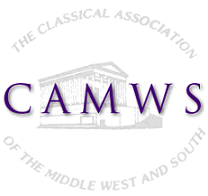Welcome to Teaching Classical Languages (TCL). TCL is the peer-reviewed, online journal dedicated to exploring how we teach (and how we learn) Greek and Latin. TCL is sponsored by the Classical Association of the Middle West and South (CAMWS).
Volume 10, Issue 2

Abstracts of Articles
Learning (and Teaching) Latin Verb Tenses: Applying Second Language Acquisition Research and Analyses of Verb Uses in Context
This article uses research from Second Language Acquisition and from analyses of tense and verb uses in Latin authors to shed light on how students acquire verb tenses, especially past tenses, and to show how to enhance student learning of Latin verb tenses. I argue that 1) only one tense and one translation/use of a tense should be taught at a time; 2) the simple past meaning of the perfect should be the first past tense taught, then the stative use of imperfect, followed by the past progressive use, the present perfect, and pluperfect; 3) it makes a difference what verbs are used in teaching a tense; there are different semantic categories of verbs, such as stative, based on their inherent meaning, and tenses are acquired best with the category of verb that best matches the tense aspect; the combination of category of verb and tense can also sometimes aid in distinguishing translations of tenses; and 4) tenses occur in typical semantic and syntactic contexts, and these contexts are important to enhance acquisition and to aid in distinguishing different tense uses/translations. Finally, I provide teaching suggestions, sample exercises, methods for adapting and supplementing textbooks, and a review of textbooks in relation to teaching verb tenses.
What can Taylor Swift do for your Latin Prose Composition students? Using popular music to teach Latin poetry analysis skills
This article presents a method for developing and practicing both close reading skills and compositional skills as used in an undergraduate Latin Prose Composition course. By using contemporary popular music, students can learn how to recognize, comprehend, and use as a basis for analysis rhetorical and literary devices found in Latin poetry as well as poetic compositional style. When students translate popular songs that they know and understand into Latin and then analyze them according to basic philological processes, they are able to remove barriers to understanding deriving from cultural differences between the Roman world and their modern world. Further, this assignment also offers a solution to the critical problem that many students have no facility with poetic analysis of poetry in their native language. In addition to seeing extensive development of philological methods in students performing this assignment, results were also seen in advanced reading Latin courses in the form of better class discussion and more mature term papers.
Never Out of Style: Teaching Latin Love Poetry with Pop Music
Students often struggle to interpret Latin poetry. To combat the confusion, teachers can turn to a modern parallel (pop music) to assist their students in understanding ancient verse. Pop music is very familiar to most students, and they already translate its meaning unconsciously. Building upon what students already know, teachers can reframe their approach to poetry in a way that is more effective. This essay shows how to present the concept of meter (dactylic hexameter and elegy) and scansion using contemporary pop music, considers the notion of the constructed persona utilizing a modern musician, Taylor Swift, and then addresses the pattern of the love affair in Latin poetry and Taylor Swift’s music. To illustrate this approach to connecting ancient poetry with modern music, the lyrics and music video from one song, Taylor Swift’s Blank Space (2014), are analyzed and compared to poems by Catullus. Finally, this essay offers instructions on how to create an assignment employing pop music as a tool to teach poetry — a comparative analysis between a modern song and Latin poetry in the original or in translation.
Music, Meaning, and the Muses: Teaching Latin Intertextuality with Wild Nothing’s “Paradise”
This paper discusses how to utilize a music video to teach Latin intertextuality. It shows how to encourage students to be aware of the way authors and musicians establish connections between their own works and those of their predecessors. The video features “signposts” for allusive material and an extended quotation that enhances the meaning of the song. Similar effects can be discovered in the analysis of Latin poetry and a case study shows how intertextual echoes in Vergil adumbrate his own literary antecedents and his creative use of his source material. This instructional strategy not only assists students to see the larger context of the Latin poems and to delve into their poetics, but also illuminates how visual clues operate within Latin poetry.

